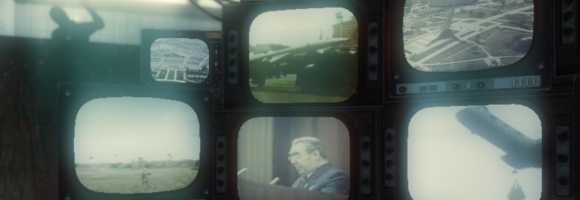
After having sent the manuscript of my book ‘↑Cyberanthropology‘ (Knorr 2011) to the editor, I went downtown in order to reward myself a bit. Perfectly aware that I’d never have time for it all, I nevertheless bought ‘↑Call of Duty: Black Ops‘ (Treyarch 2010), ‘Portal 2’ (Valve Corporation 2011), ‘↑Crysis 2‘ (Crytek 2011), and ‘↑Far Cry 2‘ (Ubisoft Montreal 2008). In a street café I treated myself with a latte macchiato, all the while wondering at the boxes of my newly acquired treasures. The collector’s edition of ‘Far Cry 2’ indeed comes in a treasure chest, containing e.g. a t-shirt.
Then I headed home, donned the Far-Cry-2 t-shirt, granted myself two days plus the night between them, and played through the single-player campaign of ‘Black Ops.’ The graphics are gorgeous, no doubt about it. At least on my machine they live up to what I have seen in the trailers.
But the storytelling is linear, resembles a movie—an interactive one, granted. The universal remedy to all kinds of problematic situations is +forward +shoot.

When I reached above pictured situation, my heart jumped in excitement. The scene I had seen in a trailer, and ingame it’s exactly as in the trailer. Disappointment followed immediately. The winter forest, somewhere inside the Soviet Union, is gorgeous, but can’t be explored. If you try to wander astray, you’ll bump into invisible walls, delineating the boundaries of the map. ‘Black Ops’ is the exact opposite of a freeroaming, sandbox game. I had no choice but following my team comrades until we reached the rapelling point, also to be seen in the trailer:
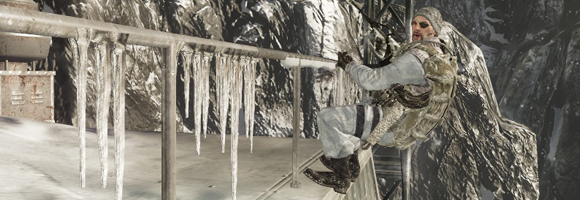
Before I realized how carefully you have to go down the ropes, I fell to death several times. Might be entirely my fault, because I never before played a title of the ‘↑Call of Duty‘ franchise, and simply am not accustomed to its peculiarities of moving around.
Be that as it may, despite the linearity, and despite my problems with the controls here and now, I got sucked into the game ever more. What I really dug is that it chases you through every conceivable cold-war theatre—even those which have turned hot. Here’s Vietnam (with a cameo appearance by Bruce Willis?):

When I got deeper and deeper into the story, I liked the settings, the scenes, and the whole story more and more. It comprises aspects and elements of a whole array of my favourites: John Frankenheimer’s ‘↑The Manchurian Candidate‘ (1962) featuring Frank Sinatra, later ↑remade by Jonathan Demme (2004) featuring Denzel Washington. ‘↑12 Monkeys‘ (Gilliam 1995) featuring Bruce Willis, and in turn based on Chris Marker’s experimental short film ‘↵La jetée‘ (1962). And then of course ‘↑Fight Club‘ (Palahniuk 1996), faithfully ↑adapted to the silver screen by David Fincher (1999), starring Brad Pitt and Edward Norton.
To say, that ‘Black Ops’ is cyberpunk would be saying too much. But vast parts of its sujets, settings, ambience, æsthetics, narrative content, and narrative strategies are subject to the discourse cyberpunk.
Time travel is a core element of ’12 Monkeys’ and ‘La Jetée,’ but does not occur in ‘Black Ops.’ Only indirectly, if you will, as the whole story is told in flashbacks. But then again there are some blunt anachronisms concerning the weapons. For example, most striking, the Heckler & Koch G11 is available ingame. Although development of said weapon already began in 1968, and first prototypes were around in late 1971, the version in ‘Black Ops,’ the G11 K2 to my eye, wasn’t available before ca. 1990—again prototypes of it, as the G11 never saw mass-production.
Nevertheless the ambience is set by all kinds of cold-war icons appearing:

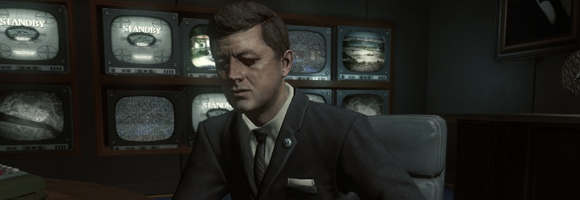

Yes, you get to fly the SR-71 ‘Blackbird,’ and, yes, you get to talk to Kennedy. And, yes, your very first objective in the story, relived in a flashback, is the assassination of Castro—↑Cuba didn’t like it.
I don’t know, if Kennedy wanted Castro assassinated—I don’t even know for sure who assassinated Kennedy.
Speaking of high-calibre assassinations and commando operations targeting international political figures—those haven’t vanished with the cold war, and not only are elements of fictitious cold-war alternate histories.
New-York based developer ↑Kuma Reality Games maintains the free tactical military first- and third-person shooter ↑Kuma\War. Almost on a monthly basis ↑new episodes can be downloaded and played. The latest is ↑Mission 108—Fall of Sirte: Gaddafi’s Last Stand. That already explains the game’s tag line: ‘Real war news. Real war games.’ Two other immensely popular missions or episodes are ↑Mission 62—Operation Red Dawn (capturing Saddam Hussein) and ↑Mission 107—The Death of Osama Bin Laden (self explanatory). If you play the latter and then compare it to the ↑meticulous write-up of the ongoings at Wikipedia, you’ll be astounded by the amount of research Kuma Reality Games does. For illustration, here is a screencap of ↑Osama Bin Laden’s compound in Abbottabad, Pakistan as depicted in Mission 107:
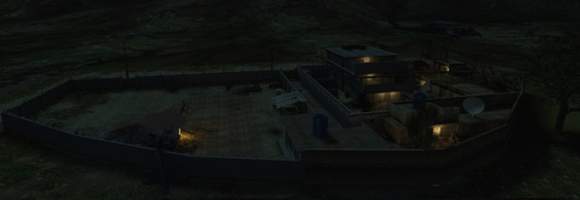
And here are the targets of missions 62 and 107:
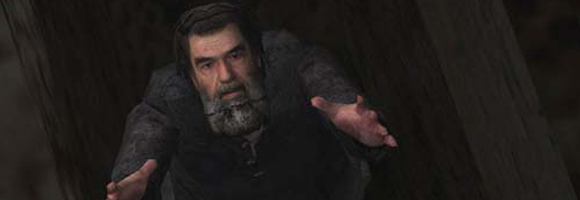
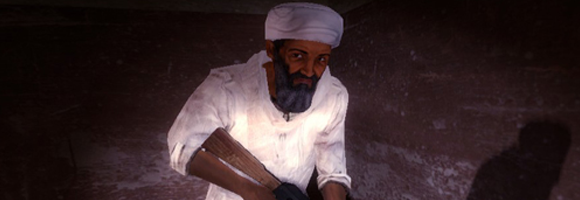
The visual material seems to teach us that sporting a big beard is counterproductive in terms of lifetime.
So, watch out ↑Bryan Alexander, ↑Eugene Burger, and ↵Alan Moore …
But then again, Castro’s still around, JFK ain’t.
who ate it?
zeph’s pop culture quiz #3

From this one I shied away, as I sincerely do loath the kitten Internet meme. But due to the fate of the kitten in the movie from which the screenshot was taken … without further ado here is this Monday’s question: Who ate the kitten?
Because ↵#1 who is it? and ↵#2 who built it? both were solved so quickly, I refrain from giving more information right from the beginning.
Just leave a comment with your educated guess—you can always ask for additional hints, and I’ll provide them. [Leaving a comment is easy; just click the ‘Leave a comment’ at the end of the post and fill in the form. If it’s the first time you post a comment, it will be held for moderation. But I am constantly checking, and once I’ve approved a comment, your next ones won’t be held, but published immediately by the system.]
UPDATE 1 (14 November 2011):
As requested, here are some more hints: The screencap of the kitten was taken from the opening of the sequel to the original. The latter was released nearly one and a half decades earlier. The lead in the original was played by someone really cool—it also was his debut appearance. Three decades after the original a remake came to the silver screen. Since then there only were rumours, but who, or what, we are searching for was not to be seen again.
UPDATE 2 (15 November 2011):
The guesses definitely get closer and closer. Here are some more hints: The director of the movie with the kitten in the beginning is well known in another context; he has experience with bottle imps and black gold. If it’s still too cryptic, I’ll post an additional screenshot tomorrow.
UPDATE 3 (17 November 2011):
In the movie Samuel the kitten isn’t the first living being to be swallowed by whom or what we are looking for:

UPDATE 4 and solution (18 November 2011):
A new contestant entered the quiz and by ↵one well-aimed shot hit it right away: ↑Beware! The Blob (Hagman 1972) it is—congratulations, ryoku! This sequel was directed by ↑Larry Hagman, who by way of ↑I Dream of Jeannie (Sheldon 1965-1970) had experience with bottle imps—the black gold thing of course referred to ↑Dallas (Moore 1978-1991). All that ryoku got, too, and more: In the original ↑The Blob (Yeaworth 1958) the ↑King of Cool himself, ↑Steve McQueen, played his very first lead.
And now to the gruesome end Samuel the kitten found:

Here we see him encountering the Blob for the first time—and it will be the last. The Blob just has freed itself from a container wherein it was stored away safely in frozen condition. Our hero still is small; it’ll grow with every living being it swallows. The fly it already has swallowed couldn’t add significantly to its mass. Samuel is quite flabbergasted but, nosey as those foolish kittens are, he misses the good sense to run.
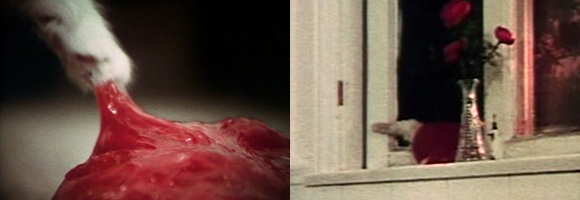
The Blob first catches his paw. That the film crew could safely do, but having Samuel sucked into that red gelatinous stuff would have enraged the animal rights activists, I guess. So, the last we get to see of Samuel is him (likely some plush toy stand-in) being dragged out of the kitchen window by the abominable adorable Blob :-)
telegeography
Amazing, how associations creep up involuntarily. When ↑Mark McGuire ↵asked if ↑Cyberanthropology was available in English, I had to answer ‘I’m afraid, but, no,’ and at the same time thought, ‘but there is a book-length unpublished manuscript in English on my HDDs.’ Then I saw the link to ↑TeleGeography’s map gallery at the ↑ethno::log and was reminded of a passage from said manuscript, ranting about the macroscopic hardware aspect of information technology:
When you are doing offline fieldwork in, say, the tropical belt, you have to be able to find your way around in the rainforest, have to know about its dangers, and how to circumvent them, have to have basic, tangible knowledge. First of all a forest is a forest, and not the dwelling place of the deceased, mythical ancestors. It may well be the latter, too—but that comes later. My point is that you can not start with what people envision the forest to be, or—even worse—what academics envision the people there envision the forest to be. The rainforest is an aggregation of plants and animals, interacting all but haphazardly—a complex biological ecosystem. This is what you have to start out with, or—in the worst case—you will not even live long enough to grasp the ancestor thing.
This leads to my second point of evidence fortifying my suspicion, that slippery paths are taken in some academic research on the online realm—blatant misconceptions of the technology at work. You have to know the forest first.
In analogy to the forest, the Internet first of all is an aggregation of software and hardware, and not ‘a social practice.’ There are the machines in which data is stored, and on which applications run. Then there are the connections between the machines—copper wires, fibreglass lines, radio links, satellites in orbit, etc. Finally there is the protocol stack, governing and managing the connections, its open standards enabling the Internet to be a ‘net of networks,’ and allowing it to grow, or change, in size, dimensions, and qualities in an unpredictable fashion.
Above that the mentioned machines are computers in the modern sense, which first of all are Universal Turing Machines, having become manifest as digital electronic technology—ultimate cybernetic systems, able to alter themselves on the software level. Nothing more, but nothing less either. Actually, that already is quite something.
You do not have to be a cutting-edge computer scientist or communications engineer, when you strive to do anthropological fieldwork online. Just as you do not have to be a botanist or eco-system buff when choosing the rainforests—but it would not hurt. The technical basics have to be grasped, or the traps of virtualism become close to inevitable.
And so on.
The point I am trying to make is not one in the direction of cultural materialism. rather I am advocating a certain honesty of the fieldworker towards her/himself. When we’re going into the rainforest we first of all envision it in terms of our own enculturation, which is heavily informed by the natural sciences. There’s no use in denying that. To the contrary, embrace it, become fully conscious of it, reflect on it, then you’ll have a chance to tap into other visions, too.
So, a revitalisation of the old ties between geography and anthropology may well make sense. Even in respect to fieldwork online.
Beyond that I simply am fascinated by the historical ↑transatlantic telegraph cable, and ↑Cyrus West Field (1819-1892) is a hero of mine ;-)
john le carré

As a youth I somehow missed the novels by ↑John le Carré. On television I had seen the iconic movie ↑The Spy Who Came in from the Cold (Ritt 1965), starring Richard Burton, but somehow never cared to read the ↑book of the same name (le Carré 1963), or any other of le Carré’s. Meanwhile I am in the process of correcting this lapse. Some weeks ago I read “The Spy Who Came in from the Cold,” which really is haunting, then proceeded to the ↑Karla Trilogy: ↑Tinker, Tailor, Soldier, Spy (1974), ↑The Honourable Schoolboy (1977), and ↑Smiley’s People (1979). I’m through with the first two, and now I am somewhere in the first fifth of “Smiley’s People.” After that I’ll proceed to le Carré’s first two novels ↑Call for the Dead (1961), and ↑A Murder of Quality (1962). In those two his most known creation, the spymaster ↑George Smiley, already is at the centre. In between I guess I’ll watch the BBC’s ingenious TV-miniseries adaptations (Irvin 1979, Langton 1982) of the first and the last book of the Karla Trilogy—”The Honourable Schoolboy” wasn’t adapted because its settings in the Southeast Asian theatre would’ve been way too expensive. George Smiley is played congenially by Sir Alec Guinness—so much so that le Carré later said that Alec Guinness in fact had taken over the character. Then it’ll be December, and I am looking forward to see one of my favourite actors of all time, ↑Gary Oldman, as George Smiley (Alfredson 2011) in the cinema.
My motivation for diving into all that has several facets.
First, le Carré’s books are a hell of a read in every respect: narrative structure, principles, and concepts, character painting, drama, suspense, language [by means of the iPhone’s integrated English-English dictionary I am learning, or trying to learn, a ton of new vocabulary], and whatyouhave.
Second, cyberpunk literature [yes, even here and now I am still on the trail of the cyberpunk discourse] on the one hand owes much to ↑hardboiled detective fiction, on the other hand is a child of the cold war—hence ↵my post on the Billion Dollar Brain. For understanding cyberpunk and for understanding the contemporary world, understanding the cold war and its representations in works of fiction is imperative. The works of John le Carré I deem to be a perfect starting point. Not only does his œuvre span from the Sixties to the cold war’s end and beyond, but the man really knows what he is talking and writing about, having been a member of the British intelligence community himself, serving with MI5 and MI6 in the 1960s.
Third, at least on an abstract level, but then again on certain historical levels as well—and you can lapidate [See? I learned a new word!] me for that—anthropology and espionage indeed do have some things in common.
Fourth, I am myself a child of the cold war. ↑Bryan Alexander is, too. After I had posted ↵Isao Hashimoto’s video, he wrote to me: “I really like Hashimoto’s video. Sadly, I find it curiously soothing. Is this a Cold War childhood thing?”
In reply, I wrote, “that’s amazing indeed, because I feel quite similarly. In my blog-entry I wrote that the video ‘gave me the creeps’ … that’s partly because it also gave me a twisted sense of comfort. And, yes, I think it definitely is a Cold War childhood thing. Especially during the last half year or so I watch a lot of Cold-War movies and got myself thrillers by e.g. Len Deighton and John le Carré. In a way digesting this material recreates a part of my childhood’s ambience.”
Now, what I really wanted to hint you at: For the series Writers & Company of Canada’s CBCradio Eleanor Wachtel visited John le Carré at his home in Cornwall in August 2010. You can listen to the interview (nearly two hours) online: ↑Part 1, ↑Part 2. Highly recommended. It’s not just about le Carré’s life and background, and for sure isn’t simply a device for marketing his latest novel ↑Our Kind of Traitor (le Carré 2010). Rather the interview conveys deep insights into our world of today.
punk galore
In 1991 ↑The Difference Engine (Gibson & Sterling 1991), a collaborative novel by ↑William Gibson and ↑Bruce Sterling, was published. The story is set in 19th century Great Britain, but—and that’s the core idea—Victorian society hasn’t developed as we can read it in the history books. Instead development went analogous paths to those the north Atlantic industrialized nation states took after World War II. Yet the key technology of the story’s universe isn’t digital electronics, but steam power. In this world mechanical computers are driven by steam engines, and so on. The novel is true to cyberpunk’s concepts and ideas, but the near future setting got replaced by an alternate history. (Sussmann 1994) A concept ↑Philip K. Dick introduced with his novel ↑The Man in the High Castle (1962). This story is set in a world where not the Allies but the Axis emerged victorious from World War II. The U.S. West coast is under imperial Japanese rule, the East coast is controlled by the Third Reich, etc.
The concept of the technologically driven alternative course of history became a widely disseminated object of fascination. A downright inflation of genre-, or sub-genre-labels set in. Meanwhile quite some terms, all constructed after the blueprint ‘steampunk,’ are around. In chronological order of the ‘technology epochs’ they are refering to: stonepunk, bronzepunk, sandalpunk, candlepunk, clock- or springpunk, steampunk, dieselpunk, atom[ic]punk, transistorpunk, and bitpunk.
All those ‘genres’ can be grouped under the superordinate concept ‘timepunk,’ as the core idea is always the same. E.g. dieselpunk renders a fictitious era from the 1920s to ’50s which is not only defined by the war, art deco, pulp-fiction heroes, and swing, but also by a diesel technology which has ‘taken off’ and dominates culture and society.
Besides steampunk, dieselpunk is the only one of the ‘sub-genres’ around which a substantial scene emerged. Both (interlocking) scenes—more than interesting for the anthropologer interested in ‘subcultures’—not only are manifest as impressive online infrastructures of interaction, but also feature rich cultural productions. Those comprise digital and material artefacts, from clothing to Victorian style computer hardware. (Knorr 2009: 166-169, Dawdy 2010: 766-767)
Yet, timepunk is more than a collection of retrofuturistic instances, which use a historical period as a starting point and pivot for narrative phantasies. For cyberpunk derivatives set in the future a similar array of terms is around. The neologisms biopunk—or ribofunk, as ↑Paul Di Filippo has suggested (1996)—, greenpunk (referring to the green revolution, namely the extensive use of specially bred seeds, fertilizers, and pesticides), and nanopunk point towards the respective technologies which are deemed to be dominant, and which are represented accordingly.
Bruce Sterling never embraced genre denominations:
Scarcely any writer is happy about labels—especially one with the peculiar ring of ‘cyberpunk.’ Literary tags carry an odd kind of double obnoxiousness: those with a label feel pigeonholed; those without feel neglected. And, somehow, group labels never quite fit the individual, giving rise to an aching itchiness. It follows, then, that the ‘typical cyberpunk writer’ does not exist; this person is only a Platonic fiction. For the rest of us, our label is an uneasy bed of Procrustes, where fiendish critics wait to lop and stretch us to fit. (Sterling 1986: vii)
So I guess he didn’t have the serious intention to complete the time bar when he proposed the term nowpunk—comprising the whole literature set in the here and now. [It’d be superfluous to add that technology has to play a role in that literature, as there hardly can be any literary text making relevant statements on the present from which technology is absent ;-] I suppose that Sterling in a tongue-in-cheek manner wanted to bring the uncontrolled growth to a grinding halt.
But that mission failed, as all the above is not yet enough. For narrative material which follows the principles and notions of cyberpunk, but draws on other genres for setting and ambience, ‘genre-punk’ terms have been invented: elfpunk, mythpunk, splatterpunk, salvagepunk, etherpunk, and stitchpunk. The last one really crowns the development, as it solely refers to the visual æsthetics of the feature-length animation film ↑9 by ↑Shane Acker (2009).
Looked upon from an analytical vantage point it is quite obvious that this kind of fragmenting genre-differentiation doesn’t make any sense. But it hints towards something: The unbroken interest in all things cyberpunk.
corpse companionship
‘Knew him personally at all, did you, sir?’ the Detective Chief Superintendent of Police asked respectfully in a voice kept deliberately low. ‘Or perhaps I shouldn’t enquire.’
The two men had been together for fifteen minutes but this was the Superintendent’s first question. For a while Smiley did not seem to hear it, but his silence was not offensive, he had the gift of quiet. Besides, there is a companionship about two men contemplating a corpse. (Le Carré 1979: chpt. 3)
clockpunk musketeers
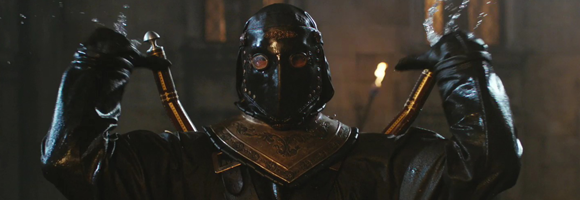
The moment he emerged from the water in full 3D glory his equipment at once reminded me of the ↵industrial tribal art, and I already liked the movie. The majority of the critics’ reviews paints a less favorable picture, though. Nevertheless those reviews pour quite some water on my mills.
Alonso Duralde for example ↑wrote for Reuters: “The creators of the umpteenth new adaptation of ‘↑The Three Musketeers‘ [Anderson 2011] decided that the classic novel really needed a giant blimp battle, high-tech booby traps, bird droppings, ‘Matrix’-esque slo-mo fight scenes and scads of computer-generated French soldiers.” [bold emphasis mine] Then he goes on to bash the movie exuberantly.
The Schlock Mercenary in turn ↑is way more friendly. Like me he seemed to have dug the movie right from the beginning:
Once we’re done scrolling past a neat, toy-soldiers-on-map version of Europe, The Three Musketeers gives us a steampunk scuba diver emerging from the canals of Venice with repeating crossbows.
Okay, so it’s going to be THAT kind of movie. I mean, if this is seventeenth-century Italy we can’t even call the scuba rig “steampunk” because there aren’t any steam engines yet.
Well, at least your expectations have been set. It’s going to be THAT kind of movie. This isn’t historical fiction by a long shot. It misses the romanticized historical mark by a wide margin as well. What you’ve got here is full-on, brass-balls to the clockwork-secret-passage-wall alternate history. And if you can make it past the waterproof repeating crossbows, you’re in for a real ride. [bold emphasis mine]
This pins it down precisely. And yes, it’s not ↑steampunk, but ↑clockpunk, another one of the timepunk varieties—to all of which steampunk is the ancestor. The whole lot in turn consists of retrofuturistic ↑cyberpunk derivatives. And here we are.
The regular reader may have noticed that I am ↵striving to show that what I call the cyberpunk discourse sprouts, flourishes, and blooms ever more. ↑Alexandre Dumas‘ classic ↑swashbuckler adventure novel “↓The Three Musketeers” (1844) is no cyberpunk at all, of course. But just like the ↵zombie genre got infested by the cyberpunk discourse, the movie adaptations of other subject matters fall prey to it, too.

In the 2011 movie “The Three Musketeers” there are no plot elements which would justify to call it a cyberpunk story. But the æsthetics of cyberpunk and its derivatives reign. Not only all the technological artefacts, from the little gadgets to the huge blimps, but also the fighting choreography—everything is subdued to it.
With ↑Paul W. S. Anderson as the director all of this is little wonder. In his first feature film ↑Shopping (1994) he already took up cyberpunkish issues and settings. His ↑Soldier (1998), a sidequel to ↑Blade Runner (Scott 1982), written by ↑David Peoples, who co-wrote the script of “Blade Runner,” is at the centre of the genre. ↑Death Race (2008) and its prequel ↑Death Race 2 (Reiné 2011—Anderson was writer and producer), and of course the ↑Resident Evil film series (Anderson 2002, Witt 2004, Mulcahy 2007 [Anderson was writer and producer of the latter two], Anderson 2010, 2012), prominently starring ↑Milla Jovovich, are all cyberpunk, too. After ↑The Fifth Element (Besson 1997) and ↑Ultraviolet (Wimmer 2006) Miss Jovovich by means of this series once and for all has established herself as the ↑ultimate cyberpunk chick kicking butt big time. So, as Milady de Winter she brings not only a lot of cuteness to “The Three Musketeers,” but a lot of cyberpunkishness, too.

who built it?
zeph’s pop culture quiz #2

The screenshot was taken from the opening of a classic horror movie. Throughout the movie vistas of the house are to be seen many times. Interestingly enough the house’s spectacular interior was not used at all—instead a mock Victorian interior was built at a sound stage. The mock-up has nothing to do with the house’s real interior, although a particular design element of the original was interspersed here and there.
Decades later the movie was remade, without the house—the stories of the remake and its sequel play in a fictitious art deco building.
But quite some directors were fascinated by the house and so it was used again and again for many movies, television productions, music videos, and advertisement shorts. So much so that the neighborhood’s residents began to complain about film crews constantly blocking roads and making noise all through the night. Some productions use the interior and exterior of the original house, some use recreations, or combinations of both—always incorporating the mentioned particular design feature.
Among these movies there is at least one absolutely groundbreaking one. And I know of one movie, of the same genre as the groundbreaking one, which uses the original interior, but is not mentioned in all the lists I’ve seen so far.
What is the name of the house and who built it?
Just leave a comment with your educated guess—you can ask for additional hints, too. [Leaving a comment is easy; just click the ‘Leave a comment’ at the end of the post and fill in the form. If it’s the first time you post a comment, it will be held for moderation. But I am constantly checking, and once I’ve approved a comment, your next ones won’t be held, but published immediately by the system.]
UPDATE and solution (08 November 2011):

To hell with him, and back again ;-) … ↵Alexander Rabitsch again did it in no time: It is ↑Ennis House built by ↑Frank Lloyd Wright in 1924. The screenshot I took from the movie ↑House on Haunted Hill (Castle 1959) starring the incomparable, immortal [Ladies and Gentlemen, will you please for a moment rise from your seats] ↑Vincent Price! I’ve got a longer post on Ennis House in the making, where I will make explicit the allusions and associations written above … as soon as time permits.
And for next Monday I really have a tough one in the making! ;-)
remember
“Remember, remember … the fifth of November!”

Well, well, the fifth of November just broke, and I’m curious what’s going to happen. If ↑Guy Fawkes, respectively ↵Alan Moore‘s “↑V for Vendetta,” and ↑its movie adaptation of the same name, on the symbolic level really is of such importance to the #OWS movement [see ↵occupy guy and ↵guy headroom], then we should expect some occupation today. Above that ↑Anonymous has announced actions against Facebook and against a mexican drug cartell—that is, if Anonymous indeed announced all of that, and not some hoaxsters. Anyway, it’s the fifth, it’s Guy Fawkes’ day. If you’re tired of having to carry the plastic version of Fawkes’ mug around all day, now there’s an alternative. Matthew Borgatti has designed an ↑OWS Guy Fawkes bandanna, printed on demand: “For every bandana ordered one will be sent to one of the Occupy branches worldwide. Double your effect and increase the anonymity!”
moving image archive
This is a straight attack on your precious time—but the weekend is dawning anyway.
The ↑Moving Image Archive has, among other goodies, a huge ↑collection of feature films, which can be viewed and/or downloaded legally for free—there are gems like ↓Night of the Living Dead. This is possible because e.g. the copyright on a movie has expired. But that does not mean that you’ll only find very old movies there. Legal curiosities force movies into the public domain, too. Like when the copyright notice by some mistake didn’t make it to the movie’s release print.
Of special interest are the ↑Film Noir section, and the ↑Sci-Fi/Horror section, of course. The latter at the moment carries 439 items. In most cases different formats are available for download, sometimes high quality ones included.
Now go and waste your time!


